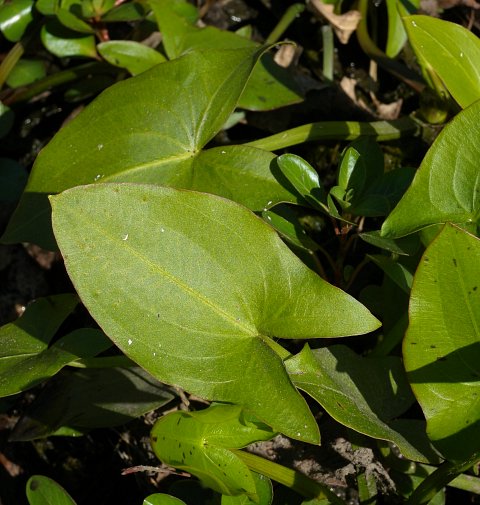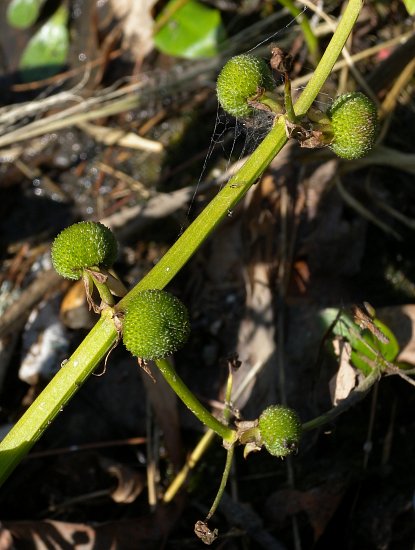
Individual flowers are about ¾-1" across. Each staminate flower consists of 3 white petals, 3 light green sepals, and a cluster of stamens with yellow anthers. Each pistillate flower consists of 3 white petals, 3 light green sepals, and a compound carpel (dense ball of pistils) that is light green. For both types of flowers, the petals are oval to orbicular in shape, while the sepals are lanceolate to ovate in shape and glabrous; the petals are longer than the sepals. The pedicels are light green, glabrous, and widely spreading to ascending; the pedicels of staminate flowers (about ½" in length) are usually longer than those of pistillate flowers (about ¼" in length). The blooming period occurs during the summer and fall, lasting 1½-3 months for a colony of plants. Afterwards, the compound carpels of the pistillate flowers are replaced by subgloboid (flattened-globoid) seedheads that are about ½-¾" across. These seedheads have a fine prickly appearance from the minute beaks of the seeds. Immature seedheads are light green or yellowish green, while mature seedheads turn brown and gradually release their seeds. The persistent sepals become strongly recurved underneath the seedheads. Individual seeds are 1.5-2.5 mm. in length, 1.0-2.0 mm. across, and flattened-obovoid in shape with winged margins. Along one side of its upper surface, each seed has an erect beak less than 0.5 mm. in length. As the seeds mature, they become more narrow in shape (flattened-oblanceoloid) and their winged margins shrink. When this plant is a floating aquatic, it produces a rosette of basal leaves with long petioles (up to 2½' long). The blades of these leaves float on the surface of the water. The leaf blades of floating aquatic plants are 2-5" long and about one-half as much across; they are usually sagittate or hastate in shape, resembling the leaf blades of emergent aquatic plants. The root system of both types of plants consist of a crown with fibrous roots and stolons that usually lie beneath the soil surface. Occasionally, these stolons produce tubers.

Cultivation: The preference is full or partial sun and shallow water that is slow-moving or stagnant. The soil underneath the water can consist of mud or sand. Occasional dry spells without standing water are tolerated if the soil surrounding the root system remains moist. Because of its emergent or floating leaves, this plant tolerates somewhat muddy water.
Range & Habitat: Arum-Leaved Arrowhead is occasional in the northern half of Illinois, where it is native (see Distribution Map). This plant is widely distributed in northeastern and midwestern United States and adjacent areas of Canada. It may be more common in Illinois than what has been reported because of possible confusion with similar Sagittaria spp. Habitats include shallow areas of ponds and lakes, margins of reservoirs, slow-moving creeks, swamps, drainage canals, marshes, and seasonal wetlands that don't completely dry out. This plant can be found in both higher quality and degraded wetlands.

Faunal Associations: The nectar and pollen of the flowers attract a variety of insects, including honeybees, bumblebees, Halictid bees, wasps, Syrphid flies, Tachinid flies, butterflies, skippers, and beetles. Other insects feed destructively on the leaves, stalks, roots, and other parts of Arum-Leaved Arrowhead and other Arrowhead species (Sagittaria spp.). These insects include leaf beetles (primarily Donacia spp.), weevils (primarily Listronotus spp.), the Waterlily Aphid (Rhopalosiphum nymphaeae), larvae of the Cattail Borer Moth (Bellura obliqua), wetland-loving grasshoppers (especially Paroxya spp.), the Short-winged Meadow Katydid (Conocephalus brevipennis), and the larvae of several caddisflies (especially Triaenodes spp.). See the Insect Table for a more complete listing of these species. Some vertebrate animals also feed on these wetland plants, especially ducks, which feed on their seeds and tubers (see the Bird Table for a listing of these species). In addition, muskrats feed on the stalk bases, crowns, and tubers (Martin et al., 1952/1962; Hamerstrom & Blake, 1939), and such turtles as Chelydra serpentina (Snapping Turtle), Chrysemys picta (Painted Turtle), Pseudemys concinna (River Cooter), and Trachemys scripta (Slider) reportedly feed on these plants (Ernst et al., 1994).

Photographic Location: A drainage canal at the Windsor Road Prairie in Champaign, Illinois.
Comments: This is one of the smaller Arrowhead species (Sagittaria spp.). It is easily confused with several other species in this genus, all of which are native to Illinois. Arum-Leaved Arrowhead can be identified by the minute straight beaks of its seeds, which are less than 0.5 mm. in length and erect. Other Arrowhead species have seeds with longer beaks that are either straight and erect, straight and horizontal, or curved. The seeds of Arum-Leaved Arrowhead also tend to be smaller in size (about 2 mm. in length) than those of similar species. Other key characteristics include basal lobes that are shorter than the main bodies (terminal lobes) of the leaves and the glabrous filaments of staminate flowers (lacking either minute scales or hairs). Arum-Leaved Arrowhead is also unusual in producing floating leaves with unusually long petioles when the plant crown is submerged in sufficiently deep water. Another common name of this species is Northern Arrowhead.